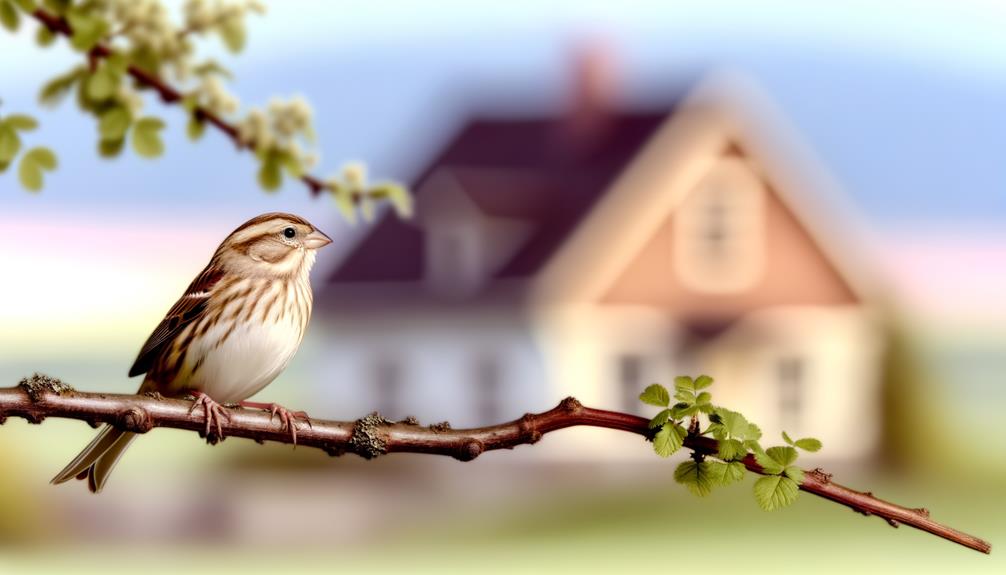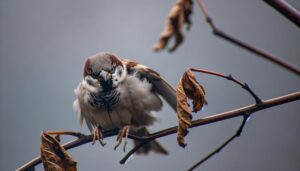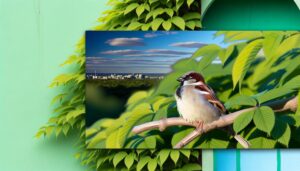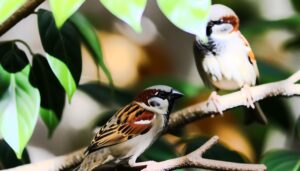7 Key Differences: Female Field Sparrows vs House Sparrows
The female Field Sparrow, measuring 12-14 cm, features a fine, pinkish bill and a clear, unmarked breast with a distinct white eye ring. Contrastingly, the larger House Sparrow (14-16 cm) displays a stout, yellowish bill and bold patterns, including a dark streak behind the eye and pronounced back streaking.
Field Sparrows forage primarily on the ground in natural, grassy habitats, while House Sparrows feed at various heights and adapt to urban environments. Vocally, Field Sparrows emit high-pitched whistles (3-5 kHz), whereas House Sparrows produce monotonous chirps (2-4 kHz).
For deeper insights into their differences, explore more here.

Key Takeaways
- Female Field Sparrows have a fine, pinkish bill, whereas female House Sparrows have a stout, yellowish bill.
- Field Sparrows feature a clear, unmarked breast and a distinct white eye-ring, unlike the more patterned House Sparrows.
- Female Field Sparrows are smaller (12-14 cm) compared to female House Sparrows (14-16 cm).
- House Sparrows are often seen in large flocks, whereas Field Sparrows forage alone or in small groups.
- Field Sparrows inhabit open grassy areas, while House Sparrows thrive in urban and suburban environments.
Physical Appearance
The physical appearance of the female Field Sparrow (Spizella pusilla) can be distinguished from the House Sparrow (Passer domesticus) through a detailed comparative analysis of their plumage, body size, and distinctive markings.
The female Field Sparrow exhibits a more slender and petite body, measuring approximately 12-14 cm in length, compared to the more robust 14-16 cm of the House Sparrow. Importantly, the Field Sparrow's bill is finer and pinkish, while the House Sparrow's is stouter and yellowish.
Additionally, the Field Sparrow has a clear, unmarked breast and a distinct eye ring, contrasting with the House Sparrow's streaked breast and lack of an eye ring. These characteristics are crucial for accurate field identification and species differentiation.
Plumage Patterns
Distinguished by their subtle yet distinct plumage patterns, female Field Sparrows and House Sparrows offer key identifiers for ornithologists and bird watchers alike.
Female Field Sparrows (Spizella pusilla) exhibit a more muted, earthy palette with a distinctive white eye-ring and a plain, unmarked breast. Their dorsal feathers are streaked with brown and gray, blending seamlessly with their natural habitat.
In contrast, female House Sparrows (Passer domesticus) display bolder patterns with a notable dark streak behind the eye, a pale cheek, and a more pronounced streaking on the back and flanks.
These comparative plumage characteristics are essential for accurate species identification in the field, facilitating ecological studies and contributing to avian biodiversity records.
Behavioral Traits
Regarding behavioral traits, female Field Sparrows and House Sparrows exhibit distinct differences, especially in their foraging habits and social interactions. Field Sparrows (Spizella pusilla) typically forage alone or in small groups, showing a preference for ground-level feeding.
Conversely, House Sparrows (Passer domesticus) are highly gregarious, often foraging in larger flocks and utilizing a broader range of feeding heights.
Key distinctions include:
- Foraging Strategy: Field Sparrows prefer solitary or small-group foraging; House Sparrows thrive in large, social flocks.
- Feeding Height: Field Sparrows primarily feed on the ground; House Sparrows utilize various heights.
- Social Structure: Field Sparrows exhibit less social interaction; House Sparrows display complex social behaviors.
- Territoriality: Field Sparrows are more territorial; House Sparrows are less so, often living in close proximity.
Habitat Preferences
Field Sparrows (Spizella pusilla) inhabit open, grassy areas with sparse shrubbery, whereas House Sparrows (Passer domesticus) are highly adaptable, commonly found in urban and suburban environments.
The Field Sparrow's preference for grasslands, meadows, and prairies reflects its reliance on these habitats for nesting and foraging, as the sparse vegetation provides both concealment and food resources.
In contrast, House Sparrows exhibit remarkable ecological plasticity, thriving in environments heavily influenced by human activity. They are frequently observed in proximity to buildings, gardens, and farms, exploiting anthropogenic structures for nesting and readily available food sources.
This divergence in habitat preference underscores the Field Sparrow's specialized niche in natural settings, while the House Sparrow exemplifies adaptability to human-altered landscapes.
Vocalizations
Regarding vocalizations, the Field Sparrow (Spizella pusilla) produces a distinctive, melodic song characterized by a series of accelerating, high-pitched whistles. This is in contrast to the House Sparrow (Passer domesticus), which emits a repetitive, monotonous series of chirps and chatter.
Detailed analysis reveals:
- Frequency Range: Field Sparrows' whistles range between 3-5 kHz, while House Sparrows' chirps are typically between 2-4 kHz.
- Complexity: The Field Sparrow's song exhibits variation in pitch and tempo, showcasing intricate patterns. Conversely, the House Sparrow's vocalizations lack such complexity.
- Purpose: Field Sparrows use their song primarily for mate attraction and territory defense. House Sparrows use their simpler calls for communication within flocks.
- Seasonality: Field Sparrows are more vocal during the breeding season, whereas House Sparrows vocalize consistently throughout the year.
Conclusion
The comparative analysis between the female Field Sparrow and the House Sparrow reveals starkly divergent characteristics. The Field Sparrow, with its delicately refined plumage and intricate vocalizations, epitomizes avian elegance, while the House Sparrow's robust physique and assertive behaviors dominate urban landscapes.
Habitat preferences starkly contrast, delineating the Field Sparrow's affinity for open fields against the House Sparrow's urban adaptability. This juxtaposition underscores the breathtaking complexity and adaptability inherent within avian species, illustrating nature's boundless diversity.






